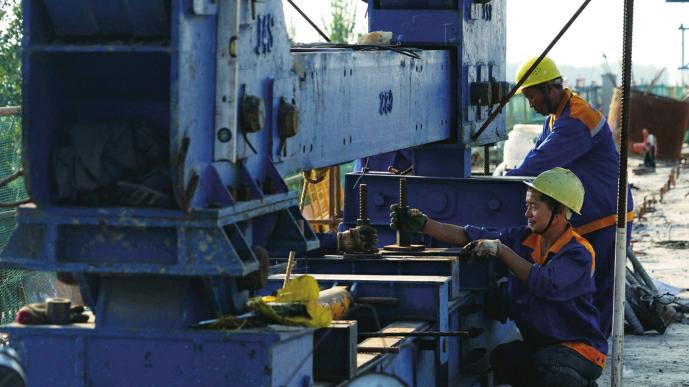Better Economy Provides Bigger Space for Reform
2017-10-22
Figures from the National Bureau of Statistics reveal that the Chinese economy performed in a stable manner and had good momentum for growth in August.
In the month, the output of industrial enterprises above the designated size—an annual revenue from their main business operations of 20 million yuan ($3.04 million)—grew 6 percent in real terms. Moreover, in the first eight months of this year, the indicator grew 6.7 percent compared to same period of last year. It should also be noted that in August, the manufacturing purchasing managers index stood at 51.7 percent, representing 13 consecutive months of expansion. This demonstrates that the manufacturing industry has maintained steady growth and corporate expectations are improving.
In addition, the surveyed unemployment rate remained below 5 percent in 31 major cities in August, a slight decline over the previous month. A total of 9.74 million jobs were created in urban areas from January to August, up 260,000 year on year.
Although the producer price index (PPI), which measures costs for goods at the factory gate, increased 6.3 percent in August, the consumer price index (CPI), a main gauge of infl ation, went up only 1.8 percent, which means that prices remained stable.
Based on these fi gures, we can see that the economy has room for future reform measures, and that progress has also been made in terms of structural adjustment and developing new growth drivers.
To begin with, progress has been made in cutting overcapacity, reducing excess inventory, deleveraging, lowering corporate costs and strengthening weak sectors of the economy. The work of cutting excess capacity in the steel and coal sectors and reducing unsold homes has accelerated. The debt-to-asset ratios and production costs of enterprises have continued to drop. And investment in ecological protection and pollution control, management of public utilities, water conservancy projects and agriculture has grown rapidly.
In terms of structural adjustment in the industrial sector, hi-tech industries continue to grow rapidly and the investment structure is optimizing.
Progress has also been made in fostering new growth drivers. In August, the growth rates of the output of hi-tech industries and the equipment manufacturing sector were 6.9 percentage points and 5.6 percentage points faster, respectively, than the average level of industrial enterprises above the designated size. Emerging services and producer services sectors have also developed rapidly. In the fi rst seven months of this year, business revenues of their enterprises above the designated size rose 16.8 and 14.5 percent year on year, respectively.endprint
To top it off, the quality of economic growth has continued to improve. From January to July of this year, profi ts in industrial enterprises above the designated size increased 21.2 percent year on year, compared to the 6.9-percent growth of 2016. In the first eight months, the general public budget revenue grew 9.8 percent from the previous year, which was higher than the growth in the fi rst half of 2017.
However, we still need to pay attention to the performance of other major economic indicators.
First of all, the growth rates of the output of industrial enterprises above the designated size, retail sales of consumer goods, fixed assets investment and foreign trade have slowed down. This means that the growth of both external and domestic demand has decreased. Short-term ups and downs are often affected by non-economic factors. For example, in July and August, high temperatures and frequent rainstorms affected production and business operation activities, which caused shortterm fluctuations. However, the slowdown was also related to structural adjustments, such as the slower growth of output of some manufacturing industries with extensive energy consumption.
Also, the month-on-month growth of the PPI in August was 0.7 percentage points higher than that of July, and the year-onyear growth jumped 0.8 percentage points after remaining flat for three consecutive months. Reasons for the faster growth may be attributed to the production curbs due to environmental protection efforts and supplyside structural reforms. It is still unknown whether CPI growth will rise as a result of the expanding PPI growth.
Judgment on economic trends must be based on long-term and comprehensive analysis. Despite this, the macro economic policies must stick to the general principle of seeking progress while maintaining stability and follow the new development concepts—innovation, coordination, eco-friendliness, opening up and sharing. We must also focus on supply-side structural reform, appropriately expand aggregate demand, promote structural adjustment and cultivate new growth drivers, so that the economy can grow more.endprint
